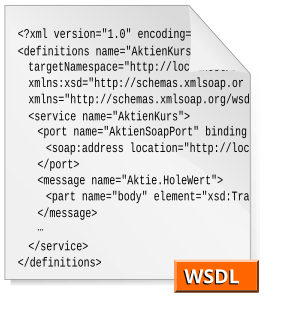Related Research Articles
A web service (WS) is either:
The Organization for the Advancement of Structured Information Standards is a nonprofit consortium that works on the development, convergence, and adoption of open standards for cybersecurity, blockchain, Internet of things (IoT), emergency management, cloud computing, legal data exchange, energy, content technologies, and other areas.
The Web Services Business Process Execution Language (WS-BPEL), commonly known as BPEL, is an OASIS standard executable language for specifying actions within business processes with web services. Processes in BPEL export and import information by using web service interfaces exclusively.
Web Services Security is an extension to SOAP to apply security to Web services. It is a member of the Web service specifications and was published by OASIS.
Web Services Discovery provides access to software systems over the Internet using standard protocols. In the most basic scenario there is a Web Service Provider that publishes a service and a Web Service Consumer that uses this service. Web Service Discovery is the process of finding suitable web services for a given task.
A web service protocol stack is a protocol stack that is used to define, locate, implement, and make Web services interact with each other. A web service protocol stack typically stacks four protocols:
Web Services Resource Framework (WSRF) is a family of OASIS-published specifications for web services. Major contributors include the Globus Alliance and IBM.
The Windows Communication Foundation (WCF), previously known as Indigo, is a free and open-source runtime and a set of APIs in the .NET Framework for building connected, service-oriented applications.
WSFL may refer to:
WS-SecurityPolicy is a web services specification, created by IBM and 12 co-authors, that has become an OASIS standard as of version 1.2. It extends the fundamental security protocols specified by the WS-Security, WS-Trust and WS-SecureConversation by offering mechanisms to represent the capabilities and requirements of web services as policies. Security policy assertions are based on the WS-Policy framework.
A workflow management system provides an infrastructure for the set-up, performance and monitoring of a defined sequence of tasks, arranged as a workflow application.

Apache ODE is a software coded in Java as a workflow engine to manage business processes which have been expressed in the Web Services Business Process Execution Language (WS-BPEL) via a website. It was made by the Apache Software Foundation and released in a stable format on March 23, 2018. The software principally communicates with one or more Web services, sending and receiving messages, manipulating data and handling exceptions (errors) as defined by any given process. The engine is capable of running both long and short living processes to coordinate all the services that make up a service or application (orchestration).
Service Component Architecture (SCA) is a software technology designed to provide a model for applications that follow service-oriented architecture principles. The technology, created by major software vendors, including IBM, Oracle Corporation and TIBCO Software, encompasses a wide range of technologies and as such is specified in independent specifications to maintain programming language and application environment neutrality. Many times it uses an enterprise service bus (ESB).

The Web Services Description Language is an XML-based interface description language that is used for describing the functionality offered by a web service. The acronym is also used for any specific WSDL description of a web service, which provides a machine-readable description of how the service can be called, what parameters it expects, and what data structures it returns. Therefore, its purpose is roughly similar to that of a type signature in a programming language.
Service choreography in business computing is a form of service composition in which the interaction protocol between several partner services is defined from a global perspective. The idea underlying the notion of service choreography can be summarised as follows:
"Dancers dance following a global scenario without a single point of control"
In computing, Open Data Protocol (OData) is an open protocol that allows the creation and consumption of queryable and interoperable REST APIs in a simple and standard way. Microsoft initiated OData in 2007. Versions 1.0, 2.0, and 3.0 are released under the Microsoft Open Specification Promise. Version 4.0 was standardized at OASIS, with a release in March 2014. In April 2015 OASIS submitted OData v4 and OData JSON Format v4 to ISO/IEC JTC 1 for approval as an international standard. In December 2016, ISO/IEC published OData 4.0 Core as ISO/IEC 20802-1:2016 and the OData JSON Format as ISO/IEC 20802-2:2016.
SOA Repository Artifact Model & Protocol (S-RAMP) is a specification of SOA repository released by HP, IBM, Software AG, TIBCO, and Red Hat. The SOA repository provides environments for designing, running and monitoring services. The repository manages artifacts like schemas, service descriptions, business process definitions and policies. The SOA Repository Artifact Model and Protocol (S-RAMP) defines a common data model for SOA repositories as well as an interaction protocol to facilitate the use of common tooling and sharing of data. This ATOM binding specifications documents the syntax for interaction with a compliant repository for create, read, update, delete and query operations. The S-RAMP specification promotes interoperability of SOA Repositories. The S-RAMP specification is one of the SOA standards.

Frank Leymann is a German computer scientist and mathematician. He is professor of computer science at the University of Stuttgart, Germany, and director and founder of the Institute of Architecture of Application Systems (IAAS).
References
- Leymann, Frank. (2001). "Web Services Flow Language (WSFL 1.0)". IBM Corporation.
- Hung, Patrick C. K. (2002). "Specifying Conflict of Interest in Web Services Endpoint Language (WSEL)". "ACM SIGecom Exchanges", Volume 3 Issue 3